Analysis of Landscape Patterns of Arid Valleys in China, Based on Grain Size Effect
Abstract
:1. Introduction
2. Materials and Methods
2.1. Study Area
2.2. Methods
2.2.1. Sample Selection
2.2.2. Choice of Landscape Metrics and Grain Size
3. Results
3.1. Impact of Landscape Metrics
3.1.1. Landscape Level
Grain Size Response Curve
Curve Fitting
3.1.2. Class Level
Grain-Size Response Curve
Curve Fitting
3.2. Landscape Pattern
3.2.1. Landscape Level
3.2.2. Class Level
4. Discussion
4.1. Impact of Grain Size on Landscape Metrics
4.2. Landscape Pattern
5. Conclusions
Acknowledgments
Author Contributions
Conflicts of Interest
References
- Remmel, T.K.; Csillag, F.; Mitchell, S.W.; Boots, B. Empirical Distributions of Landscape Pattern Indices as Functions of Classified Image Composition and Spatial Structure. Available online: https://pdfs.semanticscholar.org/23b6/4dd8f5d1dfd659494edd0cd2a84b8c08ecef.pdf (accessed on 5 December 2017).
- Fortin, M.J.; Boots, B.; Csillag, F.; Remmel, T. On the role of spatial stochastic models in understanding landscape indices in ecology. Oikos 2003, 102, 203–212. [Google Scholar] [CrossRef]
- Baldwin, D.J.; Weaver, K.; Schnekenburger, F.; Perera, A.H. Sensitivity of landscape pattern indices to input data characteristics on real landscapes: Implications for their use in natural disturbance emulation. Landsc. Ecol. 2004, 19, 255–271. [Google Scholar] [CrossRef]
- Plexida, S.G.; Sfougaris, A.I.; Ispikoudis, I.P.; Papanastasis, V.P. Selecting landscape metrics as indicators of spatial heterogeneity—A comparison among greek landscapes. Int. J. Appl. Earth Obs. Geoinf. 2014, 26, 26–35. [Google Scholar] [CrossRef]
- Schindler, S.; von Wehrden, H.; Poirazidis, K.; Wrbka, T.; Kati, V. Multiscale performance of landscape metrics as indicators of species richness of plants, insects and vertebrates. Ecol. Indic. 2013, 31, 41–48. [Google Scholar] [CrossRef]
- Wu, J. Scale and scaling: A cross-disciplinary perspective. In Key Topics in Landscape Ecology; Cambridge University Press: Cambridge, UK, 2007. [Google Scholar]
- Saura, S. Effects of remote sensor spatial resolution and data aggregation on selected fragmentation indices. Landsc. Ecol. 2004, 19, 197–209. [Google Scholar] [CrossRef]
- Wu, J. Effects of changing scale on landscape pattern analysis: Scaling relations. Landsc. Ecol. 2004, 19, 125–138. [Google Scholar] [CrossRef]
- Johnson, G.D.; Patil, G.P. Quantitative multiresolution characterization of landscape patterns for assessing the status of ecosystem health in watershed management areas. Ecosys. Health 1998, 4, 177–187. [Google Scholar] [CrossRef]
- Crow, T.R.; Perera, A.H. Emulating natural landscape disturbance in forest management—An introduction. Lands. Ecol. 2004, 19, 231–233. [Google Scholar] [CrossRef]
- Lam, N.S.N.; Quattrochi, D.A. On the issues of scale, resolution, and fractal analysis in the mapping sciences. Prof. Geogr. 1992, 44, 88–98. [Google Scholar] [CrossRef]
- Wu, J.; Qi, Y. Dealing with scale in landscape analysis: An overview. Ann. GIS 2000, 6, 1–5. [Google Scholar] [CrossRef]
- Turner, M.G.; O’Neill, R.V.; Gardner, R.H.; Milne, B.T. Effects of changing spatial scale on the analysis of landscape pattern. Landsc. Ecol. 1989, 3, 153–162. [Google Scholar] [CrossRef]
- Wiens, J.A. Spatial scaling in ecology. Funct. Ecol. 1989, 3, 385–397. [Google Scholar] [CrossRef]
- Dungan, J.L.; Perry, J.; Dale, M.; Legendre, P.; Citron-Pousty, S.; Fortin, M.J.; Jakomulska, A.; Miriti, M.; Rosenberg, M. A balanced view of scale in spatial statistical analysis. Ecography 2002, 25, 626–640. [Google Scholar] [CrossRef]
- Nagendra, H.; Munroe, D.K.; Southworth, J. From pattern to process: Landscape fragmentation and the analysis of land use/land cover change. Agric. Ecosyst. Environ. 2004, 101, 111–115. [Google Scholar] [CrossRef]
- Wu, J.; Shen, W.; Sun, W.; Tueller, P.T. Empirical patterns of the effects of changing scale on landscape metrics. Landsc. Ecol. 2002, 17, 761–782. [Google Scholar] [CrossRef]
- Wu, J.; Jelinski, D.E.; Luck, M.; Tueller, P.T. Multiscale analysis of landscape heterogeneity: Scale variance and pattern metrics. Geogr. Inform. Sci. 2000, 6, 6–19. [Google Scholar] [CrossRef] [PubMed]
- McGarigal, K.; Marks, B.J. FRAGSTATS: Spatial Pattern Analysis Program for Quantifying Landscape Structure. Available online: https://www.fs.usda.gov/treesearch/pubs/3064 (accessed on 24 November 2017).
- Jackson, N.D.; Fahrig, L. Landscape context affects genetic diversity at a much larger spatial extent than population abundance. Ecology 2014, 95, 871–881. [Google Scholar] [CrossRef] [PubMed]
- Levin, S.A. The problem of pattern and scale in ecology. Ecology 1992, 73, 1943–1967. [Google Scholar] [CrossRef]
- Uuemaa, E.; Roosaare, J.; Mander, Ü. Scale dependence of landscape metrics and their indicatory value for nutrient and organic matter losses from catchments. Ecol. Indic. 2005, 5, 350–369. [Google Scholar] [CrossRef]
- Wickham, J.D.; O’Neill, R.V.; Riitters, K.H.; Wade, T.G.; Jones, K.B. Sensitivity of selected landscape pattern metrics to land-cover misclassification and differences in land-cover composition. Photogramm. Eng. Rem. Sens. 1997, 63, 397–402. [Google Scholar]
- Amici, V.; Rocchini, D.; Filibeck, G.; Bacaro, G.; Santi, E.; Geri, F.; Landi, S.; Scoppola, A.; Chiarucci, A. Landscape structure effects on forest plant diversity at local scale: Exploring the role of spatial extent. Ecol. Complex. 2015, 21, 44–52. [Google Scholar] [CrossRef]
- Kallimanis, A.S.; Koutsias, N. Geographical patterns of corine land cover diversity across europe: The effect of grain size and thematic resolution. Prog. Phys. Geogr. 2013, 37, 161–177. [Google Scholar] [CrossRef]
- Yuan, J.; Cohen, M.J.; Kaplan, D.A.; Acharya, S.; Larsen, L.G.; Nungesser, M.K. Linking metrics of landscape pattern to hydrological process in a lotic wetland. Landsc. Ecol. 2015, 30, 1893–1912. [Google Scholar] [CrossRef]
- Scown, M.W.; Thoms, M.C.; De Jager, N.R. Measuring floodplain spatial patterns using continuous surface metrics at multiple scales. Geomorphology 2015, 245, 87–101. [Google Scholar] [CrossRef]
- Long, D.Y.; Wang, J.; Bai, Z.K.; Guo, Y.Q. Grain effect of landscape pattern index of land consolidation area in the west of songnen plain. Res. Soil Water Conserv. 2014, 21, 65–70, (In Chinese with English Abstract). [Google Scholar]
- Qiu, Y.; Yang, L.; Wang, J.; Zhang, Y.; Meng, Q.H.; Zhang, X.G. Grain effect of landscape pattern indices in a gully catchment of loess plateau, china. Acta Ecol. Sin. 2010, 21, 1159–1166, (In Chinese with English Abstract). [Google Scholar]
- Liu, Y.X.; Jiao, F. Landscape pattern characteristics and grain effect of landscape index in loess hilly region. Res. Soil Water Conserv. 2013, 20, 23–27, (In Chinese with English Abstract). [Google Scholar]
- Hou, S.Y.; Li, Y.X. Analysis on grain effect on landscape indices in mountain and plain based on gis. J. Hebei Agric. Sci. 2010, 5, 43, (In Chinese with English Abstract). [Google Scholar]
- Zhang, L.L.; Shi, Y.F.; Liu, Y.H. Effects of spatial grain change on the landscape pattern indices in yimeng mountain area of shandong province, east china. Chin. J. Ecol. 2013, 32, 459–464, (In Chinese with English Abstract). [Google Scholar]
- Ji, Y.Z.; Zhang, X.L.; Wu, J.G.; Li, H.B. Analysis of mechanism of the settlements landscape change during transforming data with several spatial granularities. Resour. Environ. Yangtze Basin 2013, 22, 322–330, (In Chinese with English Abstract). [Google Scholar]
- Fan, C.; Myint, S. A comparison of spatial autocorrelation indices and landscape metrics in measuring urban landscape fragmentation. Landsc. Urban Plan. 2014, 121, 117–128. [Google Scholar] [CrossRef]
- Wu, W.; Xu, L.P.; Zhang, M.; Ou, M.H.; Fu, H. Impact of landscape metrics on grain size effect in different types of patches: A case study of wuxi city. Acta Ecol. Sin. 2016, 9, 35, (In Chinese with English Abstract). [Google Scholar] [CrossRef]
- Zhang, R. The Dry Valleys of the Hengduan Mountains Region; Science Press: Beijing, China, 1992; (In Chinese with English Abstract). [Google Scholar]
- Yang, Z.-P.; Chang, Y.; Hu, Y.-M.; Liu, M.; Wen, Q.-C.; Zhang, W.-G. Landscape change and its driving forces of dry valley in upper reaches of minjiang river. Chin. J. Ecol. 2007. (In Chinese with English Abstract). [Google Scholar] [CrossRef]
- Yang, Z.P.; Chang, Y.; Bu, R.C.; Liu, M.; Zhang, W.G. Long-term dynamics of dry valleys in the upper reaches of mingjiang river, China. Acta Ecol. Sin. 2007, 27, 3250–3256, (In Chinese with English Abstract). [Google Scholar]
- Li, B.Y. On the boundaries of the hengduan mountains. J. Mt. Res. 1987, 2, 74–82, (In Chinese with English Abstract). [Google Scholar]
- Li, Z.X.; He, Y.Q.; Wang, C.F.; Wang, X.F.; Xin, H.J.; Zhang, W.; Cao, W. Spatial and temporal trends of temperature and precipitation during 1960–2008 at the hengduan mountains, China. Quat. Int. 2011, 236, 127–142. [Google Scholar] [CrossRef]
- Dong, D.H.; Huang, G.; Tao, W.C.; Wu, R.G.; Hu, K.M.; Li, C.F. Interannual variation of precipitation over the hengduan mountains during rainy season. Int. J. Climatol. 2017. [Google Scholar] [CrossRef]
- Wen, Z.X.; Yang, Q.S.; Quan, Q.; Xia, L.; Ge, D.Y.; Lv, X. Multiscale partitioning of small mammal β-diversity provides novel insights into the quaternary faunal history of qinghai–tibetan plateau and hengduan mountains. J. Biogeogr. 2016, 43, 1412–1424. [Google Scholar] [CrossRef]
- Yang, Q.; Zheng, D. Physico-gepgraphical feature and economic development of the dry valleys in the hengduan mountains, southwest China. J. Arid Land Res. Environ. 1988, 2, 18–23, (In Chinese with English Abstract). [Google Scholar]
- Zhang, K.; Pan, S.; Cao, L.; Wang, Y.; Zhao, Y.; Zhang, W. Spatial distribution and temporal trends in precipitation extremes over the hengduan mountains region, China, from 1961 to 2012. Quat. Int. 2014, 349, 346–356. [Google Scholar] [CrossRef]
- Ding, W.R. Trend of the climate changes in dry valleys of hengduan mountains, China. J. Ecol. Rural Environ. 2013. (In Chinese with English Abstract). [Google Scholar] [CrossRef]
- Li, M. Rational land exploitation of dry valleys in the hengduan mountains region. J. Nat. Res. 1991, 6, 326–334, (In Chinese with English Abstract). [Google Scholar]
- Sun, H.; Tang, Y.; Huang, X.J.; Huang, C.M. Present situations and its r&d of dry valleys in the hengduan mountains of sw china. World Sci-Tech R&D 2005, 3, 15, (In Chinese with English Abstract). [Google Scholar]
- Li, Y.; Bao, W.; Wu, N. Spatial patterns of the soil seed bank and extant vegetation across the dry minjiang river valley in southwest china. J. Arid Environ. 2011, 75, 1083–1089. [Google Scholar] [CrossRef]
- Dandan, Z.; Zhiwei, Z. Biodiversity of arbuscular mycorrhizal fungi in the hot-dry valley of the jinsha river, southwest china. Appl. Soil Ecol. 2007, 37, 118–128. [Google Scholar] [CrossRef]
- Zhang, Y.; Liu, J.; Wang, L. Changes in water quality in the downstream of lancangjiang river after the construction of manwan hydropower station. Resour. Environ. Yangtze Basin 2005, 14, 500–506, (In Chinese with English Abstract). [Google Scholar]
- Cai, F.L.; Zhang, J.; Hu, K.B. Distribution and area investigation of the arid valley in Sichuan province. J. Sichuan For. Sci. Technol. 2009, 30, 82–85, (In Chinese with English Abstract). [Google Scholar]
- Yan, H.; University, S.A. Arid river valley division research in sichuan province based on remote sensing. J. Sichuan Agric. Univ. 2013, 31, 182–187, (In Chinese with English Abstract). [Google Scholar]
- Roy, D.P.; Wulder, M.; Loveland, T.R.; Woodcock, C.; Allen, R.; Anderson, M.; Helder, D.; Irons, J.; Johnson, D.; Kennedy, R.; et al. Landsat-8: Science and product vision for terrestrial global change research. Rem. Sens. Environ. 2014, 145, 154–172. [Google Scholar] [CrossRef]
- Mcgarigal, K.S.; Cushman, S.A.; Neel, M.C.; Ene, E. Fragstats: Spatial Pattern Analysis Program for Categorical Maps. Available online: www.umass.edu/landeco/research/fragstats/fragstats.html S (accessed on 2 November 2017).
- ESRI (Environmental Sciences Research Institute). Available online: http://www.esri.com/ (accessed on 11 June 2012).
- Stevenson, K.J. Review of originpro 8.5. J. Am. Chem. Soc. 2011, 133, 5621. [Google Scholar] [CrossRef]
- Hay, G.; Marceau, D.; Dube, P.; Bouchard, A. A multiscale framework for landscape analysis: Object-specific analysis and upscaling. Landsc. Ecol. 2001, 16, 471–490. [Google Scholar] [CrossRef]
- Zhao, W.W.; Fu, B.J.; Chen, L.D. The effects of grain change on landcsape indices. Quat. Sci. 2003, 3, 326–333, (In Chinese with English abstract). [Google Scholar]
- Turne, M.G. Landscape Ecology: The effect of pattern on process. Ann. Rev. Ecol. Syst. 1989, 20, 171–197. [Google Scholar] [CrossRef]
- Youssoufi, S.; Foltête, J.-C. Determining appropriate neighborhood shapes and sizes for modeling landscape satisfaction. Landsc. Urban Plan. 2013, 110, 12–24. [Google Scholar] [CrossRef]
- Buyantuyev, A.; Wu, J. Effects of thematic resolution on landscape pattern analysis. Landsc. Ecol. 2007, 22, 7–13. [Google Scholar] [CrossRef]
- Liang, J.; Liu, Y.; Ying, L.; Li, P.; Xu, Y.; Shen, Z. Road impacts on spatial patterns of land use and landscape fragmentation in three parallel rivers region, yunnan province, china. Chin. Geogr. Sci. 2014, 24, 15–27. [Google Scholar] [CrossRef]
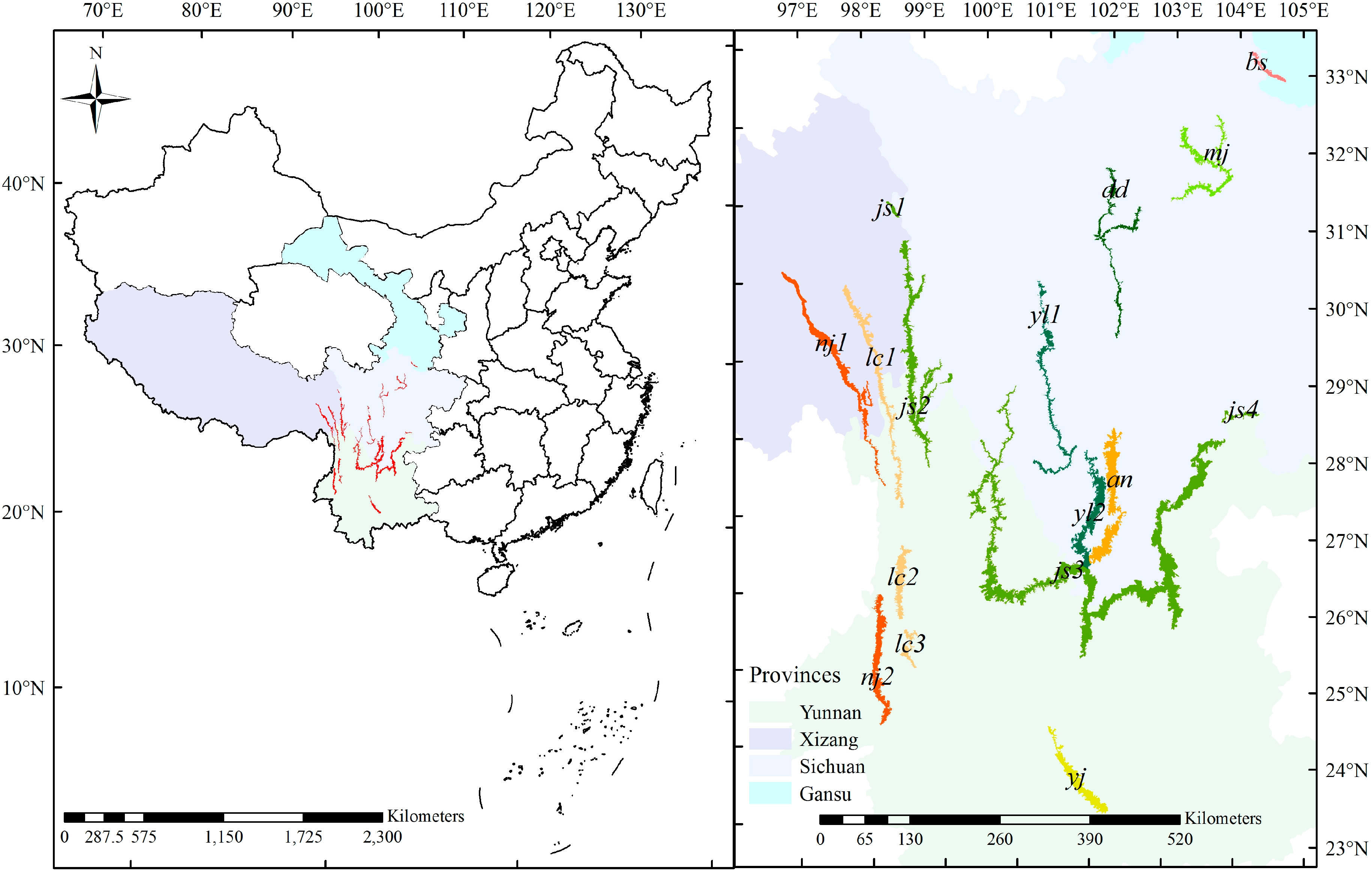
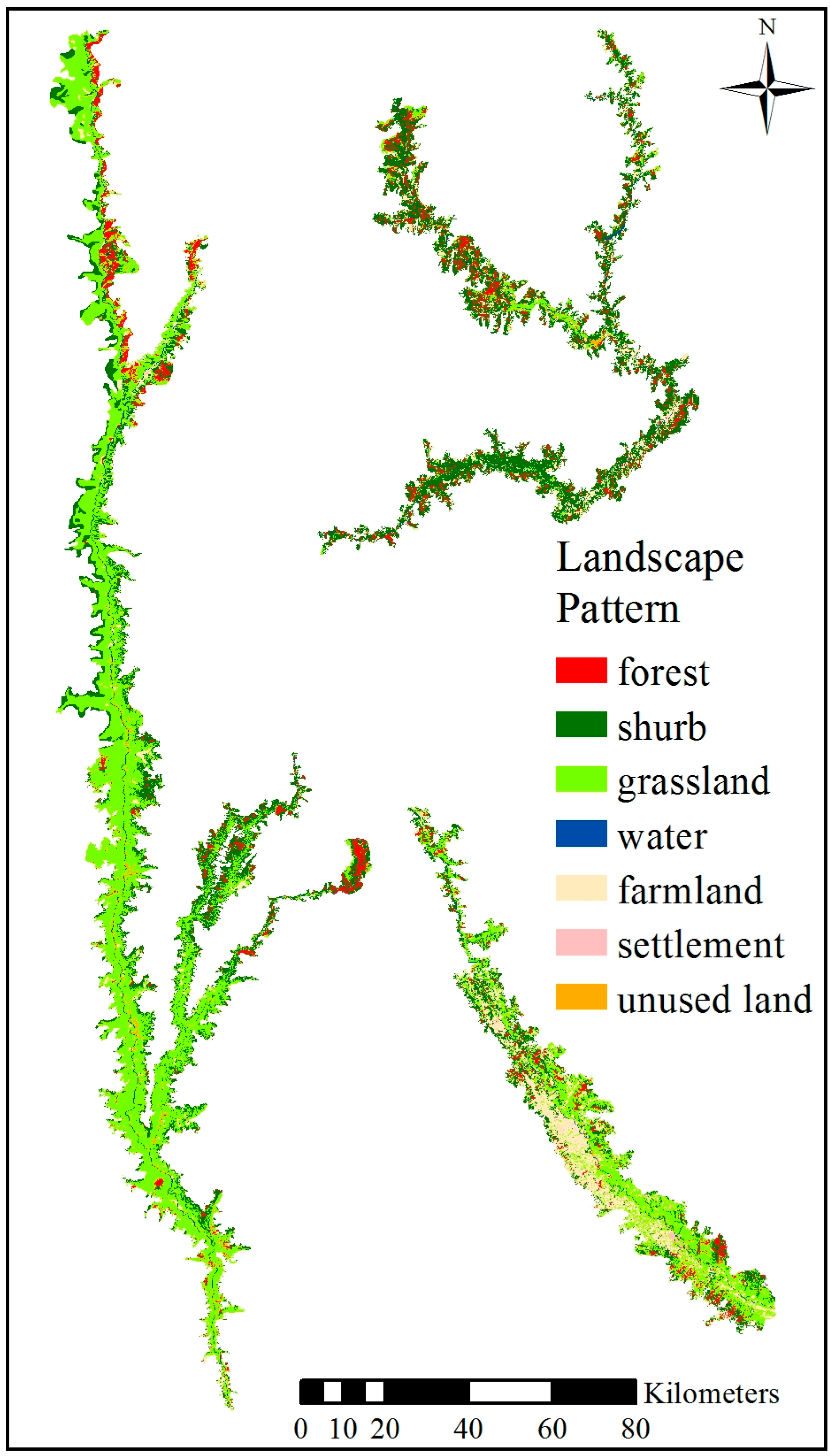

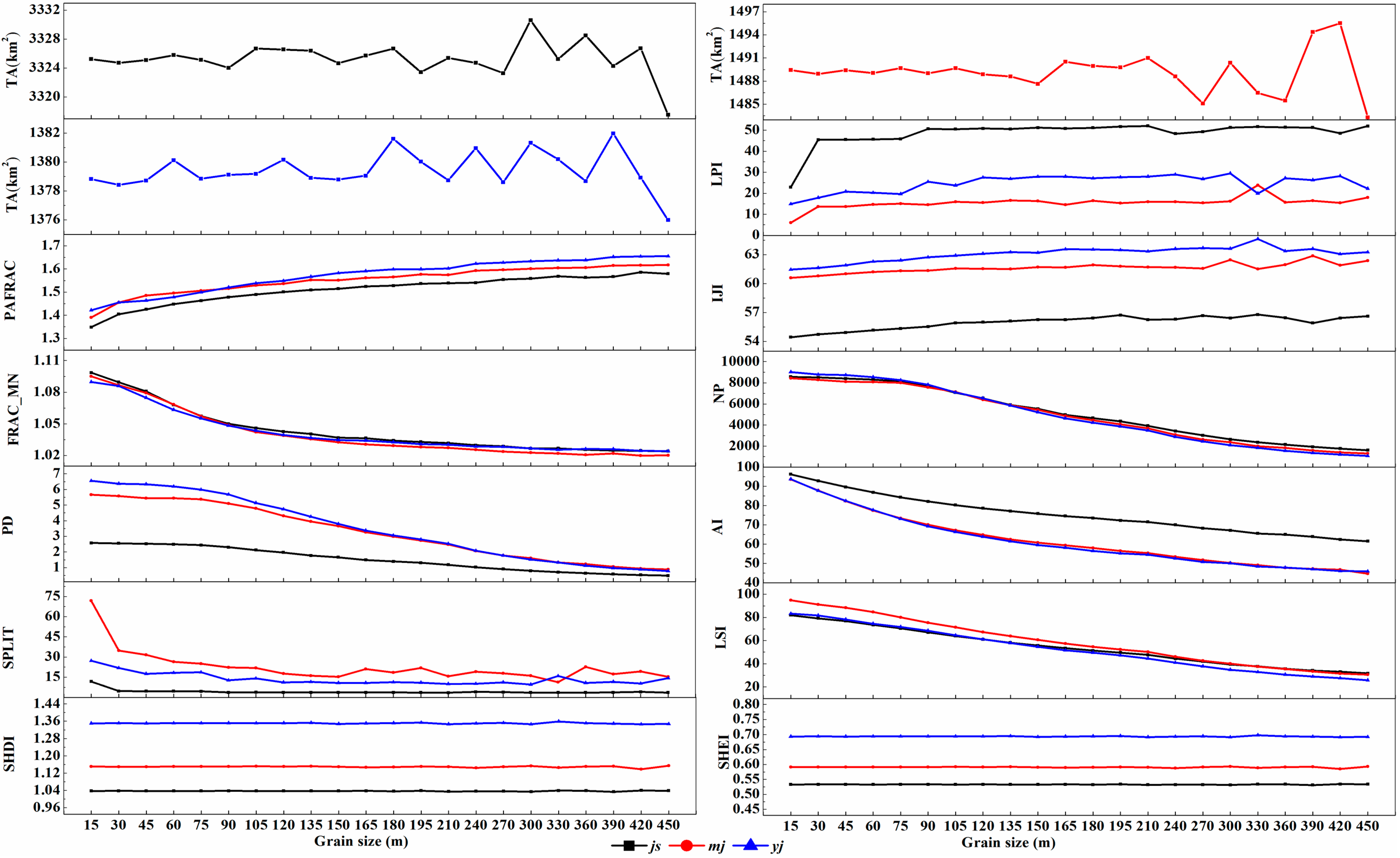
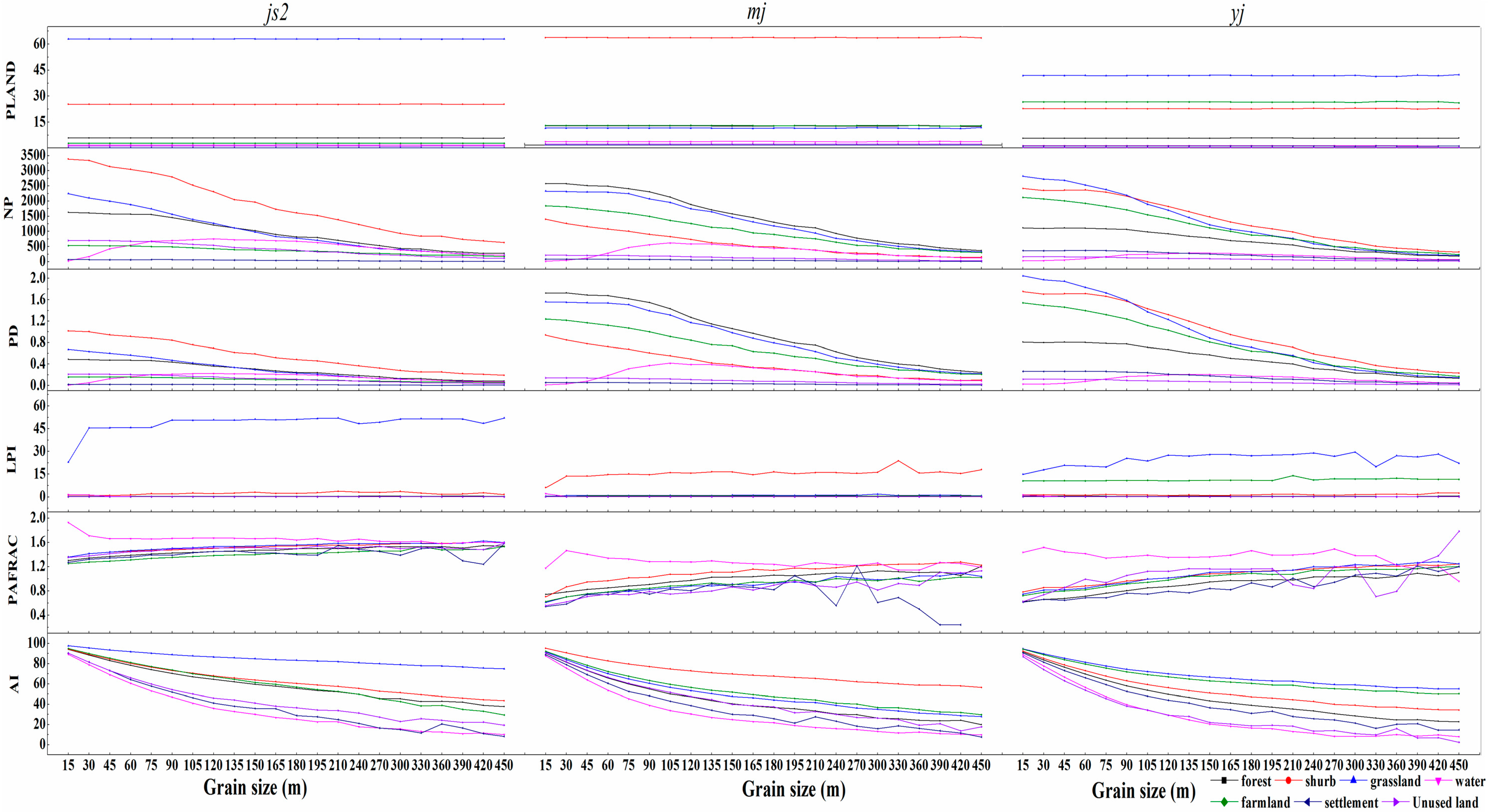
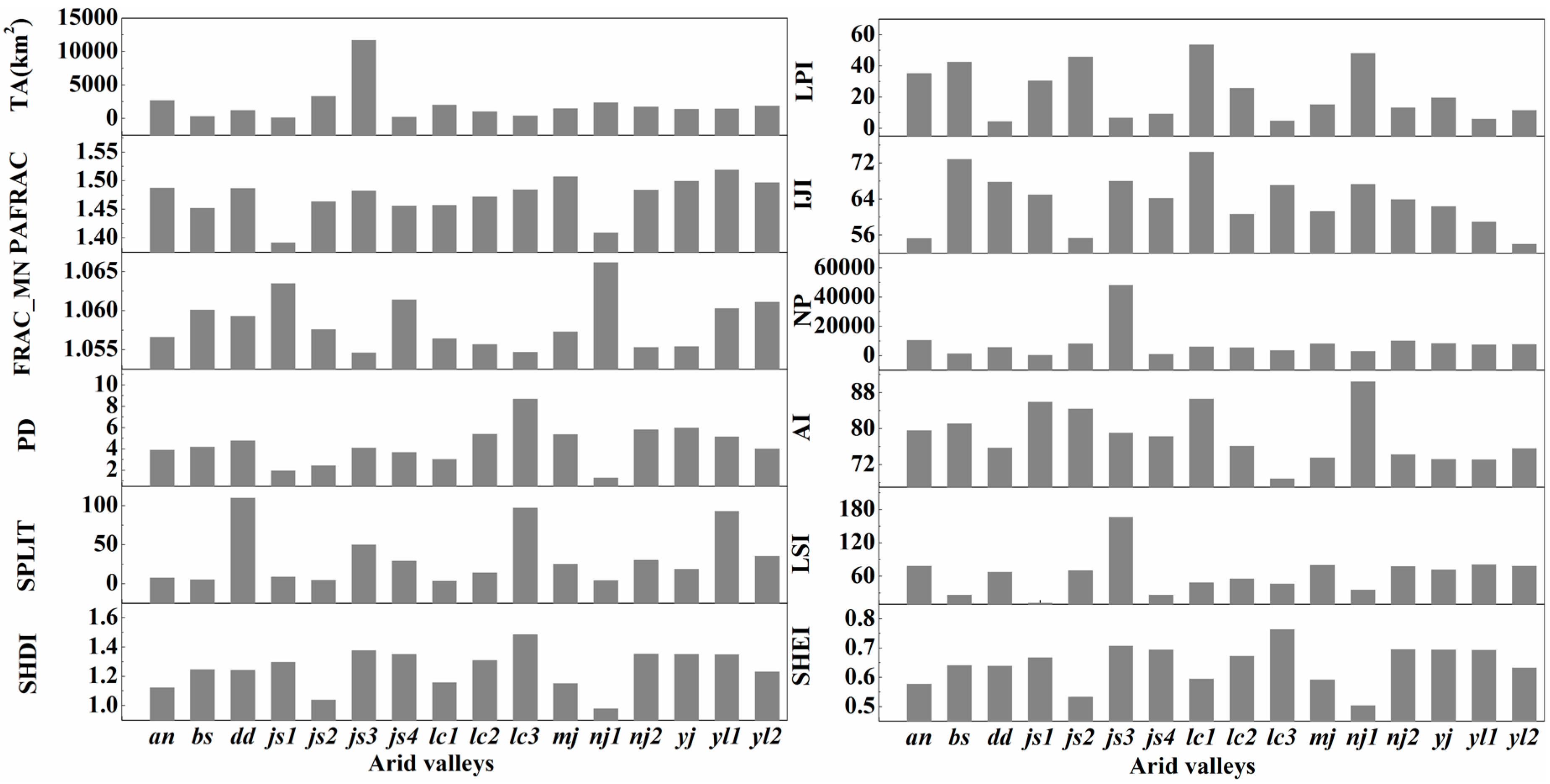
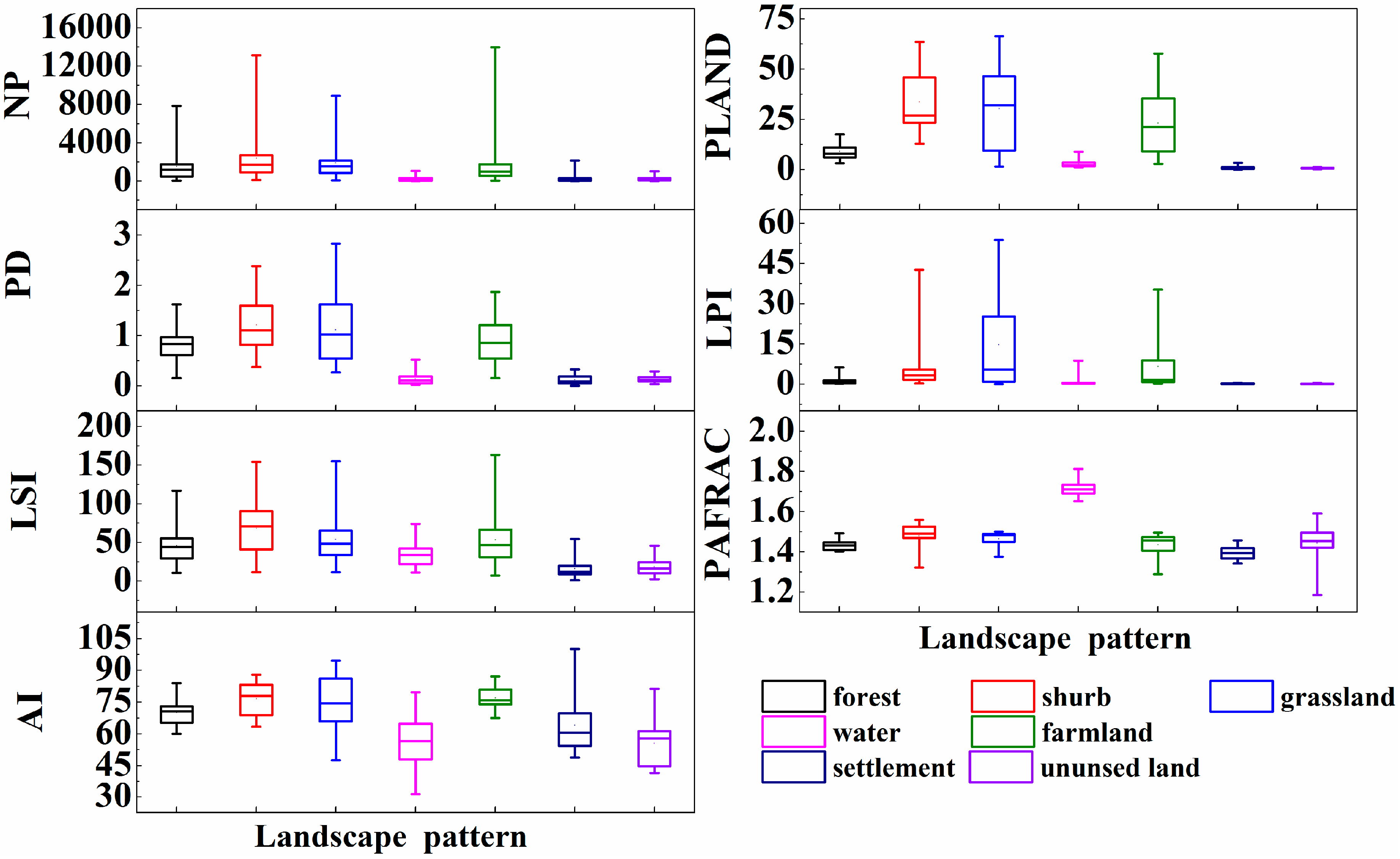
| Basin Attributes | Area (km2) | The Length of River (km) | The Length of Boundary (km) | Mean DEM (m) | Mean Slope (°) |
|---|---|---|---|---|---|
| Dadu River | 1202.11 | 229.23 | 2845.23 | 2387.66 | 29.31 |
| Yuanjiang | 1378.76 | 187.50 | 1357.49 | 807.456 | 19.41 |
| Minjiang | 1489.17 | 404.41 | 3330.44 | 2377.56 | 30.46 |
| Anning River | 2693.62 | 677.71 | 2781.95 | 1649.52 | 15.10 |
| Yalong River | 3347.99 | 340.33 | 5734.65 | 2177.29 | 27.89 |
| Lancang River | 3457.13 | 586.16 | 4197.94 | 2572.87 | 29.68 |
| Nujiang | 4100.81 | 730.54 | 3312.10 | 2264.63 | 29.13 |
| Jinsha River | 15,390.53 | 2438.28 | 15,844.28 | 1927.06 | 25.58 |
| Metrics | Name | Description |
|---|---|---|
| Area and Edge metrics | Total Area (TA) | The area of the landscape |
| Largest Patch Index (LPI) | The proportion of the largest patch area | |
| Shape metrics | Perimeter-Area Fractal Dimension (PAFRAC) | Non-randomness or degree of aggregation for different patches |
| Fractal Index Distribution (FRAC_MN) | The shape complexity of patches, which approaches 1 for shapes with simple perimeters and 2 for complex shapes | |
| Aggregation metrics | Number of Patches (NP) | The number of patches |
| Patch Density (PD) | Number of patches per unit area | |
| Splitting Index (SPLIT) | The number of patches of a landscape divided into equal sizes keeping landscape division constant, express the separation degree of individual distribution in different | |
| Interspersion and Juxtaposition Index (IJI) | The measurement of evenness of patch adjacencies and the degree of intermixing of patch types | |
| Aggregation Index (AI) | The degree of aggregation of similar patches | |
| Landscape Shape Index (LSI) | The continuity and complex of landscape shape and the measurement of the perimeter-to-area ratio for the landscape as a whole. | |
| Diversity metrics | Shannon’s Diversity Index (SHDI) | Uncertainties and landscape heterogeneity of patches |
| Shannon’s Evenness Index (SHEI) | The degree of evenness of each patch in the area, which only consider the evenness of patch sizes, not the number of patches |
| Metrics | js2 | mj | yj | |||
|---|---|---|---|---|---|---|
| Curve Fitting | R2 | Curve Fitting | R2 | Curve Fitting | R2 | |
| TA | ||||||
| LPI | S function | 0.870 | S function | 0.790 | Cubic function | 0.746 |
| PAFRAC | Log function | 0.994 | Log function | 0.991 | Log function | 0.972 |
| FRAC_MN | Cubic function | 0.987 | Cubic function | 0.991 | Cubic function | 0.988 |
| NP | Exp function | 0.989 | Exp function | 0.987 | Exp function | 0.990 |
| PD | Exp function | 0.989 | Exp function | 0.987 | Exp function | 0.990 |
| SPLIT | S FUNCTION | 0.894 | S FUNCTION | 0.827 | S FUNCTION | 0.683 |
| IJI | Cubic function | 0.933 | Cubic function | 0.751 | Cubic function | 0.897 |
| AI | Cubic function | 0.999 | Cubic function | 0.998 | Cubic function | 0.998 |
| LSI | Cubic function | 0.999 | Cubic function | 0.998 | Cubic function | 0.998 |
| SHDI | ||||||
| SHEI | ||||||
| Metrics | First Scale Domain | The Appropriate Grain Size |
|---|---|---|
| TA | The smaller, the better | |
| LPI | 30–90 m | 45–75 m |
| PAFRAC | 30–210 m | 45–195 m |
| NP | 60–105 m | 75–90 m |
| PD | 60–105 m | 75–90 m |
| SPLIT | 30–90 m | 45–75 m |
| IJI | 60–180 m | 75–125 m |
| AI | 45–240 m | 60–210 m |
| LSI | 45–105 m | 60–135 m |
| SHDI | <195 m | |
| SHEI | <195 m | |
| All | 60–90 m | 75 m |
| Metrics | js2 | mj | yj | ||||
|---|---|---|---|---|---|---|---|
| Patch | Curve Fitting | R2 | Curve Fitting | R2 | Curve Fitting | R2 | |
| PLAND | Forest | ||||||
| Shrub | |||||||
| Grass | |||||||
| Water | |||||||
| Farmland | |||||||
| Settlement | |||||||
| Unused land | |||||||
| NP | Forest | Cubic function | 0.995 | Cubic function | 0.997 | Cubic function | 0.992 |
| Shrub | Cubic function | 0.995 | Cubic function | 0.984 | Cubic function | 0.995 | |
| Grass | Cubic function | 0.991 | Cubic function | 0.994 | Cubic function | 0.990 | |
| Water | Cubic function | 0.518 | Cubic function | 0.490 | Cubic function | 0.399 | |
| Farmland | Cubic function | 0.984 | Cubic function | 0.996 | Cubic function | 0.996 | |
| Settlement | Cubic function | 0.950 | Cubic function | 0.985 | Cubic function | 0.977 | |
| Unused land | Cubic function | 0.996 | Cubic function | 0.990 | Cubic function | 0.987 | |
| PD | Forest | Cubic function | 0.995 | Cubic function | 0.997 | Cubic function | 0.992 |
| Shrub | Cubic function | 0.995 | Cubic function | 0.984 | Cubic function | 0.995 | |
| Grass | Cubic function | 0.991 | Cubic function | 0.994 | Cubic function | 0.990 | |
| Water | Cubic function | 0.519 | Cubic function | 0.490 | Cubic function | 0.400 | |
| Farmland | Cubic function | 0.984 | Cubic function | 0.996 | Cubic function | 0.996 | |
| Settlement | Cubic function | 0.950 | Cubic function | 0.985 | Cubic function | 0.977 | |
| Unused land | Cubic function | 0.996 | Cubic function | 0.990 | Cubic function | 0.987 | |
| LPI | Forest | S FUNCTION | 0.708 | Cubic function | 0.609 | Cubic function | 0.484 |
| Shrub | S FUNCTION | 0.458 | Cubic function | 0.487 | Cubic function | 0.524 | |
| Grass | Exp function | 0.547 | S FUNCTION | 0.499 | S FUNCTION | 0.551 | |
| Water | Power function | 0.909 | S FUNCTION | 0.408 | Exp function | 0.541 | |
| Farmland | Cubic function | 0.526 | Cubic function | 0.500 | Cubic function | 0.817 | |
| Settlement | Cubic function | 0.471 | Cubic function | 0.477 | Cubic function | 0.281 | |
| Unused land | Cubic function | 0.585 | Cubic function | 0.484 | Cubic function | 0.773 | |
| PAFRAC | Forest | Power function | 0.987 | Power function | 0.934 | Power function | 0.951 |
| Shrub | Power function | 0.995 | Power function | 0.974 | Power function | 0.966 | |
| Grass | Power function | 0.969 | Power function | 0.973 | Power function | 0.958 | |
| Water | Cubic function | 0.830 | Cubic function | 0.346 | Cubic function | 0.503 | |
| Farmland | Power function | 0.951 | Power function | 0.954 | Power function | 0.961 | |
| Settlement | Cubic function | 0.376 | Cubic function | 0.562 | Cubic function | 0.937 | |
| Unused land | Power function | 0.733 | Power function | 0.821 | Cubic function | 0.338 | |
| AI | Forest | Exp function | 0.984 | Exp function | 0.988 | Exp function | 0.987 |
| Shrub | Exp function | 0.984 | Exp function | 0.992 | Exp function | 0.988 | |
| Grass | Cubic function | 0.997 | Cubic function | 0.998 | Exp function | 0.989 | |
| Water | Exp function | 0.981 | Exp function | 0.963 | Exp function | 0.947 | |
| Farmland | Cubic function | 0.998 | Cubic function | 0.998 | Exp function | 0.989 | |
| Settlement | Exp function | 0.978 | Exp function | 0.980 | Exp function | 0.983 | |
| Unused land | Exp function | 0.988 | Exp function | 0.988 | Exp function | 0.969 | |
| Metrics | Basin | First Scale Domain | The Appropriate Grain Size |
|---|---|---|---|
| PLAND | js2 | The smaller, the better | |
| mj | <125 m | ||
| yj | <135 m | ||
| NP | js2 | 60–135 m | 75–125 m |
| mj | 60–135 m | 75–125 m | |
| yj | 60–135 m | 75–125 m | |
| PD | js2 | 45–195 m | 60–180 m |
| mj | 45–195 m | 60–180 m | |
| yj | 45–195 m | 60–180 m | |
| LPI | js2 | <150 m | |
| mj | <150 m | ||
| yj | <120 m | ||
| PAFRAC | js2 | 45–135 m | 60–120 m |
| mj | 45–150 m | 60–135 m | |
| yj | 45–165 m | 60–150 m | |
| AI | js2 | 60–120 m | 75–105 m |
| mj | 45–180 m | 60–165 m | |
| yj | 60–195 m | 75–180 m | |
| All | 60–135 m | 75 m |
© 2017 by the authors. Licensee MDPI, Basel, Switzerland. This article is an open access article distributed under the terms and conditions of the Creative Commons Attribution (CC BY) license (http://creativecommons.org/licenses/by/4.0/).
Share and Cite
Fang, S.; Zhao, Y.; Han, L.; Ma, C. Analysis of Landscape Patterns of Arid Valleys in China, Based on Grain Size Effect. Sustainability 2017, 9, 2263. https://doi.org/10.3390/su9122263
Fang S, Zhao Y, Han L, Ma C. Analysis of Landscape Patterns of Arid Valleys in China, Based on Grain Size Effect. Sustainability. 2017; 9(12):2263. https://doi.org/10.3390/su9122263
Chicago/Turabian StyleFang, Shu, Yonghua Zhao, Lei Han, and Chaoqun Ma. 2017. "Analysis of Landscape Patterns of Arid Valleys in China, Based on Grain Size Effect" Sustainability 9, no. 12: 2263. https://doi.org/10.3390/su9122263





